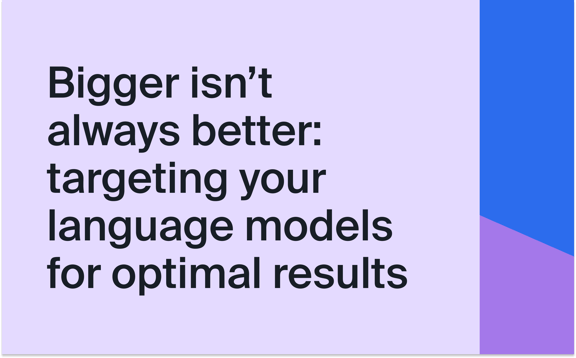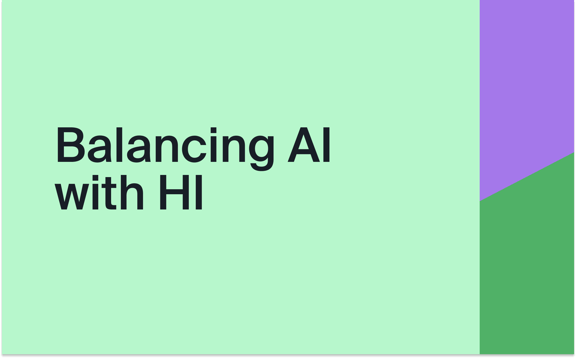Human behavior is uniquely complex. Psychological, emotional, and often inexplicable, it’s difficult to analyze and occasionally impossible to predict. Behavior differs from group to group and even person to person, and it’s an experience and phenomenon exclusive to the human condition — so it’s ironic that our most accurate tools for said analysis and prediction are, in fact, machines.
But how exactly does AI fit into the world of insights? What methods and processes underpin the speed and accuracy with which this technology analyzes and predicts human behavior? Here, we dive into the trends and science shaping the world of AI.

“Recently we’ve been observing a change in momentum away from building the world’s largest language model and into building smaller ones that excel at specific tasks. More parameters — meaning the sheer size of these models — no longer mean better performance,” says Ben Roe, Head of Product at Yabble.
We see this reflected in AI-powered insights tools, where it’s generally tricky to produce accurate results using large language models. Models of this size require you to be particularly careful with the data you input versus the results you get, meaning you need to fine-tune accordingly.
Fine-tuning is an integral part of achieving success with language models. If your data isn’t relevant to the corpus data (a collection of text and speech data used to train machine learning systems and to indicate what the optimal AI output should be), your results will be sub-par.
But there’s a tradeoff — more fine-tuning means better performance on specific tasks and worse performance on general tasks.

“Another thing that’s become more popular recently is instructional processing of tasks, where models are passed specific instructions about what tasks they need to perform,” Ben says. “Most observe a marked improvement in quality and accuracy, however this does raise questions about long-term “intelligence” of the language model. Are we fine-tuning too much based on these instructions? Do we risk “dumbing it down” by continuing on this path?”
Machine learning, the AI technology at the core of automated insights generation, is essentially a set of rules used by a neural network to perform a specific task (a neural network is a technological system designed to mimic the human brain). It’s typically best to have the initial rules created by humans (either a team or an individual subject matter expert) and to compare the machine’s results with human-generated results. Then, you fine-tune the machine output to more closely resemble the human output.
Really, though, neural networks alone aren’t enough; if you want an AI to perform a highly specific task such as generating insights from unstructured text data, you need to explicitly train it to do so. The true impact of AI in insights, then, comes from overlaying proprietary intelligence (aka custom-built algorithms) atop these networks, creating a unique tool that’s specifically engineered to quickly and accurately generate keen insights into human behavior.

“We build AI to automate the mundane tasks that have always been part of a researcher’s day-to-day,” Ben says. “We’re not here to replace jobs, as is often the fear with anything related to AI. It’s actually quite the opposite; we’re here to empower researchers, to eliminate the boring and manual work, and to help them spend their time performing the tasks that have the most value and impact — the ones where the “human intelligence” is needed.”
Xero, he notes, is an excellent example of this; far from replacing accountants, AI has automated the tedious aspects of their jobs, giving them the tools and time to more effectively help their clients.
AI is rapidly becoming critical to any effective research and insights program; according to a recent Yabble study conducted with insights industry experts in the United States and Australia, 21% of specialists already use AI tools, and 53% say they expect to use them more in the future.
“AI is really the future of insights,” Ben says. “As we move forward technologically, it’s becoming the only viable option for businesses that want to maximize the value of their data and to do so accurately and cost-effectively.”
The years since 2019 have thrown our world into chaos. Unpredictable at the best of times, human behavior has become erratic and capricious, prompting uncertainty within businesses that need reliable ways to predict future consumer behaviour. In the wake of COVID-induced volatility, it’s increasingly clear that it’s not enough to merely make an educated guess about what your customers want.
Instead, the only way to guarantee you’re delivering what they need (and to give yourself the best chance of growth and success) is to take the words straight from your audience’s mouth — and then mine that feedback for insights you can use to drive change.
With the right combination of proprietary algorithms and AI, these tools can provide both high-level overviews and granular detail on data from a myriad sources, from survey responses and product reviews to social media comments and call center transcripts. In essence: the ability of AI-powered tools to generate behavioral insights far outstrips that of the humans whose behaviour they’re analyzing.
So why not leverage these machines we’ve created to gain a better, more complete understanding of ourselves?
Book a personalized demo below to experience the power of AI in insights for yourself.
